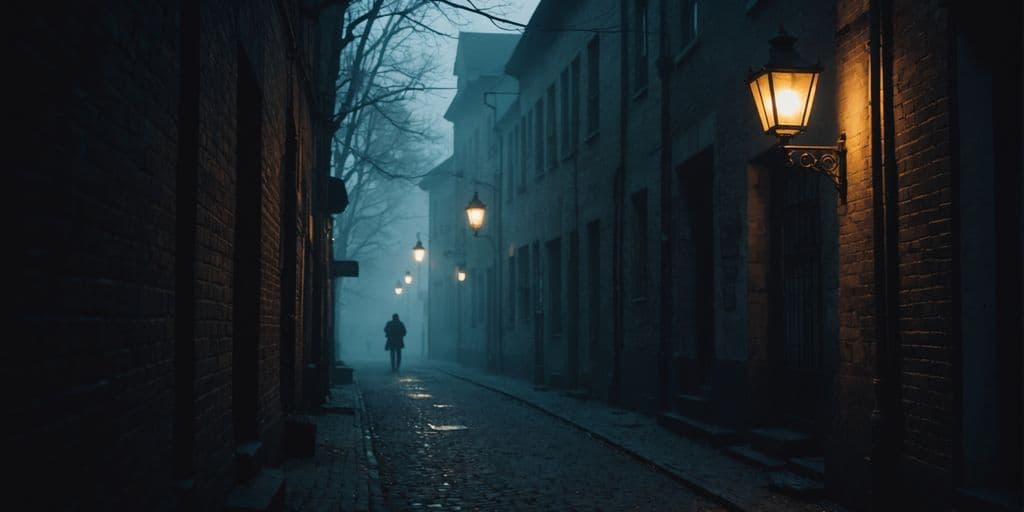Urban legends have always fascinated us, blending the line between myth and reality. What makes them even more intriguing are the true crime stories that sometimes lie behind these eerie tales. This article dives into some of the most famous urban legends and uncovers the chilling real-life events that may have inspired them.
Key Takeaways
- Urban legends often mix elements of truth and fiction, making them both captivating and terrifying.
- The story of Polybius, an arcade game that supposedly caused strange behavior, ties into real FBI investigations in the 1980s.
- The Woman in Black legend from the Appalachian region was fueled by sightings of a real woman dressed in black, sparking widespread media attention.
- Christopher Thomas Knight, known as the North Pond Hermit, lived in isolation for 27 years, inspiring campfire stories and local folklore.
- The Red Room, an internet horror tale, became infamous after a real-life school attack in Japan, blurring the lines between online fiction and reality.
The Legend of Polybius: The Arcade Game That Never Was
Origins of the Polybius Myth
In the early 1980s, a mysterious arcade game called Polybius allegedly appeared in several arcades around Portland, Oregon. The game was said to be highly addictive, causing intense psychological effects on its players. Rumors spread that men in black suits would visit the arcades to collect data from the machines. The game supposedly vanished without a trace after only a month, leaving behind a trail of urban legend and speculation.
The FBI Raids and Their Connection
During the same period, there were reports of FBI raids on arcades in Portland. These raids were not related to mind control experiments but were part of an investigation into illegal gambling activities. The timing of these raids fueled the myth of Polybius, leading many to believe that the game was part of a secret government project.
Modern-Day Investigations
Despite numerous investigations and extensive research, no concrete evidence of Polybius has ever been found. The legend persists, with some claiming to have played the game or seen it in action. The story of Polybius remains a fascinating example of how urban legends can capture the imagination and endure over time.
The tale of Polybius perfectly captures the era’s distrust of new technology and the fear of government surveillance.
The Woman in Black: A Modern-Day Phantom
The Appalachian Legend
In the Appalachian region, tales of the Woman in Black have been whispered around campfires for generations. This mysterious figure is often described as a woman dressed in a long, black gown, wandering the roads at night. Some say she is the ghost of a woman who lost her family in a tragic accident, forever searching for them. Others believe she is a harbinger of doom, appearing before disasters strike. The legend has deep roots in the local culture, blending elements of grief and mystery.
The Viral Sensation
The legend of the Woman in Black took a modern twist when sightings of her began to surface on social media. Photos and videos of a woman in black wandering the streets at night went viral, sparking a wave of investigations and crimes. People from all over the world shared their own encounters and theories, turning the Woman in Black into an internet sensation. This viral phenomenon brought the legend into the digital age, blending folklore with modern technology.
The Real Woman Behind the Legend
As the legend grew, so did the curiosity about the real identity of the Woman in Black. Investigative journalists and amateur sleuths dug into historical records and local lore, uncovering stories of women who might have inspired the legend. One theory suggests that the Woman in Black was a widow who roamed the streets after losing her husband in a mining accident. Another theory points to a woman who was wrongfully accused of a crime and spent her days in mourning. While the true identity of the Woman in Black remains a mystery, these stories add a layer of human tragedy to the legend.
The North Pond Hermit: A Tale of Isolation
Campfire Stories and Burglaries
In the quiet woods of Maine, a man lived alone for 27 years. Known as the North Pond Hermit, he survived by stealing food and supplies from nearby cabins. His presence became a local legend, with many sharing tales around campfires about the mysterious burglar who left no trace.
The Arrest of Christopher Thomas Knight
The legend took a turn when Christopher Thomas Knight was arrested in 2013. He had been living in the woods since 1986, avoiding human contact. His arrest ended years of speculation and fear among the local community.
Life After Solitude
After his arrest, Knight struggled to adjust to life outside the woods. He expressed a longing for the solitude he once had, finding it difficult to adapt to modern society. His story remains a fascinating example of extreme isolation and its impact on the human spirit.
The Red Room: From Internet Horror to Real-Life Crime
The Red Room legend is a psychological cyber-thriller that has haunted the internet for years. It began as an Adobe Flash horror animation on Geocities, telling the story of a boy cursed by a pop-up on his computer. The curse led to his untimely demise, blurring the line between fiction and reality. This eerie tale took a dark turn in 2004 when a schoolgirl attacked her classmate, allegedly influenced by the cursed website bookmarked on her computer. The incident highlighted the disturbing connection between online urban legends and real-life actions, making the Red Room a chilling example of how digital myths can manifest in the physical world.
Hotel Hell: The Dark History of The Maribel Caves Hotel
In the coastal county of Manitowoc, Wisconsin, there lies a decrepit building that used to be called The Maribel Caves Hotel. In its heyday, it was a travel destination for a high-luxury clientele. But there was a sinister side to this premium travel destination. The building was allegedly taken over by organized crime when the business went under. As legend has it, the ghosts and spirits still haunt the grounds. Some have even claimed that the building used to stand over a portal to hell. The building was partially destroyed thanks to a tornado in 2013. Let’s hope that didn’t awaken any ancient demonic spirits.
The House Under the Lake: Gardner Lake’s Sunken Mystery
The 19th Century Family’s Plan
In the late 1800s, a family living by Gardner Lake in Connecticut decided they wanted a better view from the other side of the lake. They came up with a bold plan to move their entire house across the frozen lake during winter. This idea seemed brilliant at first, but it quickly turned into a disaster.
The Sinking Incident
As the house was being moved across the ice, the unthinkable happened. The ice cracked, and the house began to sink into the lake’s icy depths. The family watched in horror as their home disappeared beneath the surface. This incident left the community in shock and gave birth to numerous legends about the sunken house.
Modern-Day Legends and Sightings
Today, Gardner Lake is known for its eerie atmosphere and mysterious happenings. Locals and visitors alike have reported strange sightings and unexplained phenomena around the lake. Some say they can still see the outline of the house under the water, while others claim to hear ghostly whispers at night. These stories have made Gardner Lake a popular spot for those seeking a chilling adventure.
Lakes are often serene escapes, drawing visitors with their calm waters and picturesque landscapes. Yet, some lakes harbor dark secrets beneath their tranquil surfaces. Gardner Lake is one such place, where whispers of the past linger in the air and mysterious happenings keep the legend alive.
Don’t Eat the Candy: The Dark Side of Halloween Treats
Halloween is a time for costumes, spooky decorations, and, of course, candy. But behind the fun and games lies a chilling urban legend that has haunted parents for decades: the fear of tainted Halloween treats. This legend has sparked a moral panic, leading many to question the safety of the candy their children collect from strangers.
Le Loyon: The Ghost of Maules
For years, the mysterious figure known as Le Loyon has been spotted wandering the forests of Maules, Switzerland. Dressed in a military-style cloak and a gas mask, this enigmatic character has fueled countless rumors and urban legends. Locals have reported seeing Le Loyon on numerous occasions, often describing the encounters as eerie and unsettling.
In 2013, a photograph of Le Loyon went viral, bringing the legend to international attention. The image, captured by a hiker, showed the figure standing in the woods, staring directly at the camera. This photo sparked a wave of online discussions and theories about the identity and motives of Le Loyon. Some speculated that the figure was a survivalist, while others believed it to be a ghost or an otherworldly being.
Shortly after the viral photo, reports of Le Loyon sightings abruptly stopped. This sudden disappearance only added to the mystery, leading many to wonder what had happened to the elusive figure. Some believe that Le Loyon simply moved to a different location, while others think that the figure may have met a tragic end. To this day, the true story behind Le Loyon remains unknown, leaving the legend shrouded in mystery.
Familiar Cadavers: The Ethical Dilemmas of Medical Education
In the early days of medical education, obtaining cadavers for dissection was a significant challenge. Grave-robbing became a common practice in the 18th and 19th centuries as medical schools struggled to find enough bodies for their students to study. This led to numerous ethical and legal issues, as the bodies were often taken without the consent of the deceased or their families.
In 1982, a shocking incident occurred at the University of Alabama. A medical student recognized one of the cadavers as her great aunt. This incident highlighted the ongoing ethical concerns surrounding the use of unclaimed bodies in medical education. The student was promptly given a replacement cadaver, but the event raised questions about the ethical standards in place at medical schools.
Today, the use of cadavers in medical education is governed by strict ethical guidelines. These standards ensure that bodies are obtained legally and with proper consent. Medical schools now rely on donations from individuals who choose to have their bodies used for scientific purposes. Despite these improvements, the history of cadaver use in medical education serves as a reminder of the importance of maintaining ethical practices in the field.
The issue of unclaimed bodies in medical education continues to be a topic of discussion, as it raises questions about equity and ethical concerns.
Key Ethical Standards in Modern Medical Education
- Informed Consent: Bodies must be donated with the explicit consent of the individual or their next of kin.
- Transparency: Medical schools must be transparent about how cadavers are used and ensure that donors’ wishes are respected.
- Respect and Dignity: Cadavers must be treated with the utmost respect and dignity throughout the educational process.
The evolution of ethical standards in medical education reflects a growing awareness of the need to balance scientific advancement with respect for human dignity.
The Devil’s Tree: A Florida Legend with a Dark Past
The Urban Legend of the Devil’s Tree
In the small town of Port St. Lucie, Florida, there lies a tree with a dark and eerie reputation. Known as the Devil’s Tree, this oak has been the center of many spooky tales. Locals whisper about a girl who was attacked by two men, often described as gang members or Satanists, who then hung her body from the tree’s branches. The tree is said to be a site for satanic rituals, with its bark appearing burned and covered in strange marks.
The True Crime Behind the Legend
The real story behind the Devil’s Tree is even more chilling. In 1972, two young women, Susan Place and Georgia Jessup, were murdered by Gerard John Schaefer, a former sheriff’s deputy. Their bodies were found buried near the tree months later. Schaefer, who was linked to the deaths of at least 26 women, would lure his victims with his badge, tie them to trees, and then kill them. The discovery of Place’s and Jessup’s bodies turned the tree into a symbol of horror.
The Park’s Modern-Day Hauntings
Today, Oak Hammock Park, where the Devil’s Tree stands, is a place of both curiosity and fear. Visitors report feeling an eerie presence and seeing ghostly figures near the tree. Some even claim to hear whispers and footsteps when no one is around. Despite its ominous history, the park remains a popular spot for those intrigued by the supernatural.
Sometimes, the truth behind urban legends is a lot scarier than ghosts and goblins.
The Playing Card Killer: A Real-Life Horror Story
The Legend of The Alice Killings
Fans of Creepypasta are well aware of “The Alice Killings.” For the uninitiated, they were a series of crimes in Japan. The culprit would leave a playing card next to the victims’ bodies with the name ”Alice” written in blood. But this real-life crime bears an eerie resemblance to the online horror story.
Alfredo Galán Sotillo’s Reign of Terror
In 2003, Alfredo Galán Sotillo terrorized the streets of Madrid, Spain. He would leave playing cards next to the bodies of his victims. The media appropriately dubbed him “The Playing Card Killer.” It’s alleged that seeing his nickname in the newspapers encouraged him to continue his horrific rampage. He eventually turned himself in and claimed that the playing cards were more of an afterthought after seeing the detail depicted in the news.
The Media’s Role in the Legend
The media played a significant role in shaping the legend of Alfredo Galán Sotillo. Seeing his nickname in the newspapers may have fueled his desire to continue his crimes. The sensational coverage blurred the lines between fact and fiction, making it difficult to separate the real-life horror from the urban legend.
Conclusion
Urban legends have always fascinated us, blending the line between fiction and reality. These chilling tales often stem from real-life events, making them even more spine-tingling. From haunted hotels to mysterious apparitions, these stories remind us that sometimes, truth is stranger than fiction. As we delve into these legends, we uncover the dark and eerie aspects of human history and imagination. So, the next time you hear a spooky story, remember that there might be a grain of truth behind it. Stay curious, stay cautious, and always question the shadows in the night.
Frequently Asked Questions
What is the Polybius legend?
The Polybius legend is about a mysterious arcade game from the 1980s that supposedly caused players to experience strange effects like amnesia and night terrors. It was rumored to be part of a government experiment.
Who was the Woman in Black?
The Woman in Black is a figure from Appalachian folklore who was believed to appear to men who had done wrong. In modern times, she was identified as a military veteran who gained attention by traveling across the country.
What is the story of the North Pond Hermit?
The North Pond Hermit refers to Christopher Thomas Knight, who lived in the woods of Maine for 27 years, surviving by stealing supplies from nearby cabins. He was caught in 2013 and has since lived a quiet life.
What is the Red Room legend?
The Red Room legend started as an online horror story about a cursed pop-up that led to the death of those who saw it. It gained notoriety after being linked to a real-life school attack in 2004.
What happened at the Maribel Caves Hotel?
The Maribel Caves Hotel, once a luxury destination, fell into disrepair and became associated with organized crime and hauntings. It was partially destroyed by a tornado in 2013.
What is the mystery of Gardner Lake’s sunken house?
In the 19th century, a family tried to move their house across the frozen Gardner Lake in Connecticut. The house fell through the ice and sank, leading to modern-day legends and sightings of the sunken home.
Why are people afraid of Halloween candy?
The fear of Halloween candy being tampered with stems from real incidents, like a dentist giving out laxative-laced candy in 1959 and a woman handing out arsenic traps in the 1960s, fueling ongoing fears of poisoned treats.
What is the story of Le Loyon?
Le Loyon, also known as the Ghost of Maules, was a figure seen in a Swiss forest wearing a cloak and gas mask. Sightings stopped after a viral photo in 2013 and a note titled ‘Death Certificate and Testament of the Ghost of Maules’ was found.




